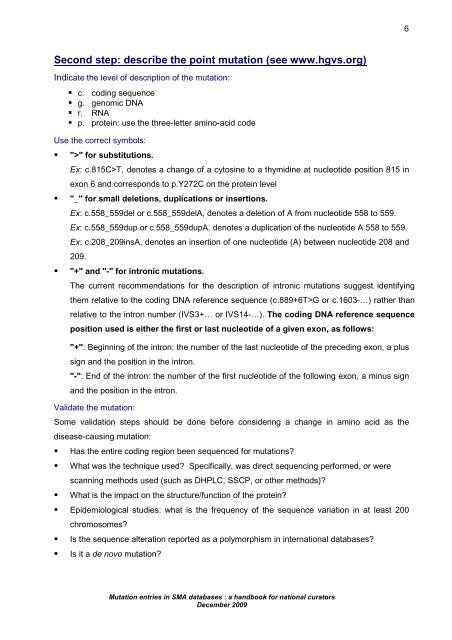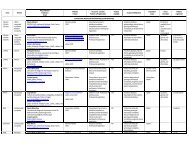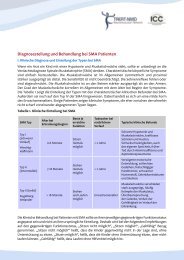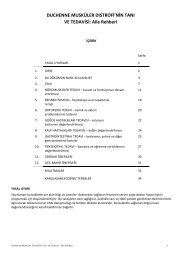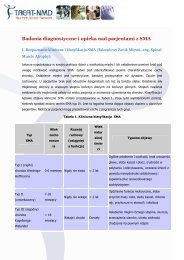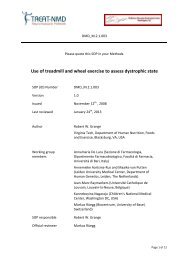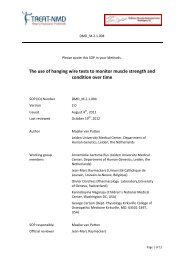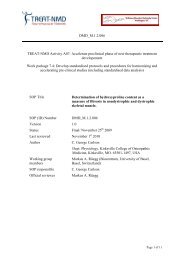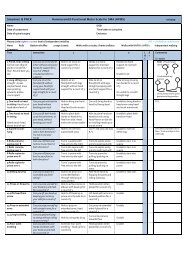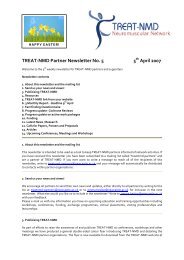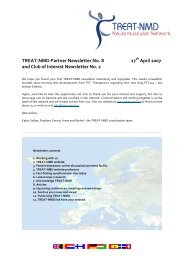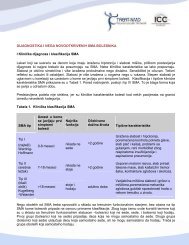A handbook on SMA genetics - Treat-NMD
A handbook on SMA genetics - Treat-NMD
A handbook on SMA genetics - Treat-NMD
Create successful ePaper yourself
Turn your PDF publications into a flip-book with our unique Google optimized e-Paper software.
6<br />
Sec<strong>on</strong>d step: describe the point mutati<strong>on</strong> (see www.hgvs.org)<br />
Indicate the level of descripti<strong>on</strong> of the mutati<strong>on</strong>:<br />
c. coding sequence<br />
g. genomic DNA<br />
r. RNA<br />
p. protein: use the three-letter amino-acid code<br />
Use the correct symbols:<br />
">" for substituti<strong>on</strong>s.<br />
Ex: c.815C>T, denotes a change of a cytosine to a thymidine at nucleotide positi<strong>on</strong> 815 in<br />
ex<strong>on</strong> 6 and corresp<strong>on</strong>ds to p.Y272C <strong>on</strong> the protein level<br />
"_" for small deleti<strong>on</strong>s, duplicati<strong>on</strong>s or inserti<strong>on</strong>s.<br />
Ex: c.558_559del or c.558_559delA, denotes a deleti<strong>on</strong> of A from nucleotide 558 to 559.<br />
Ex: c.558_559dup or c.558_559dupA, denotes a duplicati<strong>on</strong> of the nucleotide A 558 to 559.<br />
Ex: c.208_209insA, denotes an inserti<strong>on</strong> of <strong>on</strong>e nucleotide (A) between nucleotide 208 and<br />
209.<br />
"+" and "-" for intr<strong>on</strong>ic mutati<strong>on</strong>s.<br />
The current recommendati<strong>on</strong>s for the descripti<strong>on</strong> of intr<strong>on</strong>ic mutati<strong>on</strong>s suggest identifying<br />
them relative to the coding DNA reference sequence (c.889+6T>G or c.1603-…) rather than<br />
relative to the intr<strong>on</strong> number (IVS3+… or IVS14-…). The coding DNA reference sequence<br />
positi<strong>on</strong> used is either the first or last nucleotide of a given ex<strong>on</strong>, as follows:<br />
"+": Beginning of the intr<strong>on</strong>: the number of the last nucleotide of the preceding ex<strong>on</strong>, a plus<br />
sign and the positi<strong>on</strong> in the intr<strong>on</strong>.<br />
"-": End of the intr<strong>on</strong>: the number of the first nucleotide of the following ex<strong>on</strong>, a minus sign<br />
and the positi<strong>on</strong> in the intr<strong>on</strong>.<br />
Validate the mutati<strong>on</strong>:<br />
Some validati<strong>on</strong> steps should be d<strong>on</strong>e before c<strong>on</strong>sidering a change in amino acid as the<br />
disease-causing mutati<strong>on</strong>:<br />
Has the entire coding regi<strong>on</strong> been sequenced for mutati<strong>on</strong>s?<br />
What was the technique used? Specifically, was direct sequencing performed, or were<br />
scanning methods used (such as DHPLC, SSCP, or other methods)?<br />
What is the impact <strong>on</strong> the structure/functi<strong>on</strong> of the protein?<br />
Epidemiological studies: what is the frequency of the sequence variati<strong>on</strong> in at least 200<br />
chromosomes?<br />
Is the sequence alterati<strong>on</strong> reported as a polymorphism in internati<strong>on</strong>al databases?<br />
Is it a de novo mutati<strong>on</strong>?<br />
Mutati<strong>on</strong> entries in <strong>SMA</strong> databases : a <str<strong>on</strong>g>handbook</str<strong>on</strong>g> for nati<strong>on</strong>al curators<br />
December 2009


